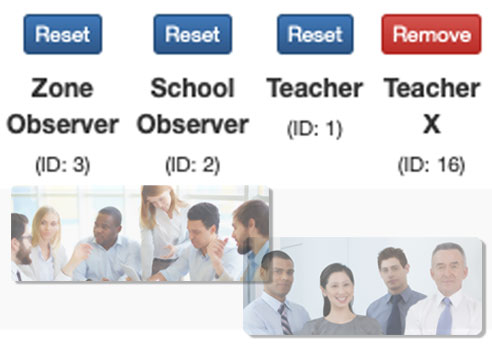Using the TIM and TIM Tools in Your Own Research
The Florida Center for Instructional Technology encourages the use of the Technology Integration Matrix and TIM Tools in research and evaluation. On this page, you will find examples of how to cite the TIM as well as information on licensing the TIM Tools for research purposes. We recommend visiting the Research page to find examples of how others have leveraged the TIM in their work. We are always happy to discuss your research or evaluation plan and offer suggestions. Please contact our Client Operations Manager to arrange a time to discuss your project with one of our researchers.
Citing the TIM and TIM Tools
To cite the Technology Integration Matrix itself:
APA
Florida Center for Instructional Technology. (2019, June 1). Technology Integration Matrix. Retrieved from https://fcit.usf.edu/matrix/matrix/
MLA
“The Technology Integration Matrix.” The Technology Integration Matrix, Florida Center for Instructional Technology, 1 June 2019, fcit.usf.edu/matrix/matrix/.
Chicago
Florida Center for Instructional Technology. “The Technology Integration Matrix.” Last modified June 1, 2019. https://fcit.usf.edu/matrix/matrix/.
To cite the TIM Tools as a suite:
APA
Florida Center for Instructional Technology. (2019, June 1). TIM Evaluation Tools. Retrieved from https://fcit.usf.edu/matrix/evaluation-tools/
MLA
“TIM Evaluation Tools.” The Technology Integration Matrix, Florida Center for Instructional Technology, 1 June 2019, fcit.usf.edu/matrix/evaluation-tools/.
Chicago
Florida Center for Instructional Technology. “TIM Evaluation Tools.” Last modified June 1, 2019. https://fcit.usf.edu/matrix/evaluation-tools/.
To reference the foundational concepts of the TIM, we suggest the following source:
Harmes, J. C., Welsh, J. L., & Winkelman, R. J. (2016). A framework for defining and evaluating technology integration in the instruction of real-world skills. In S. Ferrara, Y. Rosen, & M. Tager (Eds.), Handbook of research on technology tools for real-world skill development (pp. 137-162). Hershey, PA: IGI Global. Electronic version of the chapter available from publisher.
Licensing the TIM Tools for Research
(For the purposes of this discussion, we’ll refer to the TIM Tools school license as an individual license and the TIM Tools district license as a site license since the terms “individual” and “site” make more sense in a university context.)
In most universities, it is the responsibility doctoral candidates to license evaluation tools for their own dissertation research. Some universities, however, have already licensed TIM Tools for their students and faculty to use. If you are interested in using the TIM Tools in your research, contact us to see if your institution already has a site license.
In most cases, the smallest individual license is adequate for dissertation research purposes. The individual license includes all of the TIM Tools suite, but has a simplified administrative structure and reporting options. Even though this version of TIM Tools was designed with a single school in mind, it can be used with participants across multiple school sites. The internal reporting features will display all participants as though they were at the same location. Nevertheless, all data is downloadable and may be sorted as desired using the provided Excel templates or imported into the researcher’s preferred statistical program. The individual license is what we usually recommend when consulting with individual doc students.
The university site license has the same set of tools as the individual license, but it adds a robust administrative structure. This version of TIM Tools is used in large public school districts around the country many of which have complex administrative structures and teacher populations greater than some entire states. The Super Administrator of a site license would create a “zone” for each researcher to work in. Each zone can be created with any number of schools within it. Within one’s own zone, participants can be added to any of the schools, data collected, and reports created. The researcher may choose to group participants by their school or, as is often the case, the researcher will use the school designation to group participants by treatment group. If your university does not maintain a site license for TIM Tools, you may try to make the case for that since a site license is much more cost effective than the purchase of individual licenses.
Please see our Annual Subscription Pricing page for current rates.
For More Information….
Review these TIM research posts from our Teaching and Learning with Technology blog.
TIM Tools for Dissertation Research
We regularly correspond with graduate students planning to use TIM Tools as a part of their doctoral research. The Technology Integration Matrix is frequently used as a theoretical framework in studies of classroom technology integration because it is uniquely situated as a leveled model that focuses on the pedagogical dimensions of technology use.
TIM-Powered Research and Evaluation
In a previous post I highlighted updates to our published research page and mentioned several ways we are seeing the Technology Integration Matrix (TIM) used in research studies. In this post I would like to give a little more information about each of these…
Video: TIM Tools for Dissertations
In this presentation, Dr. James Welsh reviews the Technology Integration Matrix from a research perspective and briefly introduces the specific tools of the TIM Tools suite most frequently utilized in dissertation and other research work.
Leveraging TIM Tools Roles for Research and Evaluation
The addition of customizable roles in TIM Tools v6.0 has made it convenient to create and track different groups when evaluating technology initiatives, PD programs, or other interventions. The new roles feature defines eight different sets of permissions, or roles,…
How many observations do I need?
Here’s a great question I recently received: In your experience, what are the optimal numbers of TIM Lesson Plan (TIM-LP) reviews per teacher and TIM Observations (TIM-O) per teacher to get actionable data? This is an interesting question and there is no…
How often should we administer the TUPS?
We are sometimes asked how often the Technology Uses and Perceptions Survey (TUPS) should be administered. The answer, of course depends entirely upon your purposes, the implementation timeline, and the professional development opportunities available to your…
Three ARTI Scenarios
Most districts begin their use of TIM Tools with the TUPS to capture a snapshot of their technology and professional development needs. They then begin implementing the TIM-O with their teachers. And then, well, they often don’t get to the equally useful action…
Want To Know More?
Schedule a personal walk-through of the TIM Tools for yourself or your staff. See how this flexible set of technology integration tools will meet your school or district's specific needs.







